Building Recycling Societies

Toyoda Gosei uses resources effectively and contributes to a recycling society by reducing waste volumes*1 and water usage and designing products that are easily recyclable.
- *1 We are currently attempting to reduce waste volumes to meet our FY2020 target as we move toward minimization of industrial waste as set forth in the TG 2050 Environmental Challenge.
Basic philosophy
To move closer to the recycling society envisioned in the TG 2050 Environmental Challenge, Toyoda Gosei aims to minimize industrial waste and water usage and we are making every effort to use resources effectively, reducing materials usage and waste volumes through sorting and the design of easily recyclable products.
Frequent water shortages and floods have become a major problem in all parts of the world. We are attempting to identify these risks in every country and region where we have operations while also striving to give back to the community by reducing water usage, recycling water, and releasing cleaner wastewater.
Waste reduction
Development of product recycling technology
We develop and design easily recyclable products and materials with thought to the entire lifecycle of automobiles. We are also developing recycling technology for waste material. So far we have established recycling technologies for products that use multiple types of rubber and products that use rubber and different materials. In FY2017 we continued our recycling efforts for effective use of resources.
■Development of technology for end-of-life vehicle parts recycling
| Key items | Measures implemented |
|---|---|
| New recycling |
|
| Use of recycled materials in vehicles |
|
| Product design for easy recycling |
|
Reduction of waste materials in the production stage
To reduce waste in production processes and achieve our 2020 targets, we are combating waste at its source and recycling. We have also started a waste reduction project with coordination among plants and production technology, materials technology, and product design departments to strengthen efforts to combat waste at its source. At each plant, we are reducing waste through genchi-genbutsu (go and see), identifying items for reduction with the help of external experts, and implementing rubber, plastic, and liquid reductions.
Study sessions are also held to promote waste reduction at both domestic and international Group companies.
■Waste volume, waste volume per sales unit (index)*2
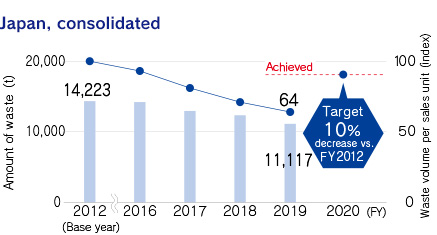
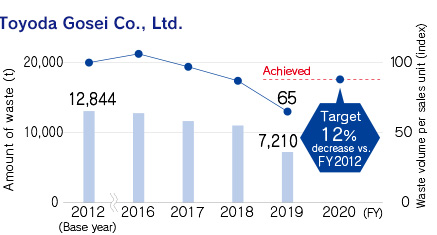
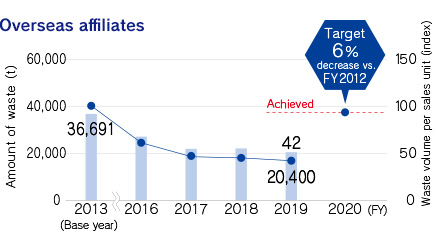
- *2 The amount of waste per sales unit (index) is a figure obtained
taking the base year as 100
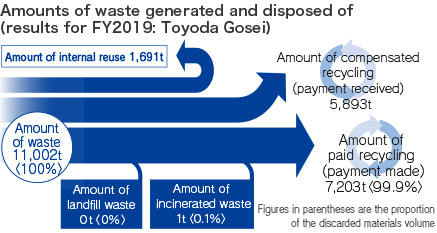
Waste reduction from design of airbag pads that can be easily taken apart*3
Previously, the pad and metal were riveted and caulked. As a result, when there was a problem the product could not be taken apart and it all had to be disposed of as waste, including good components. By switching to a fixation method that allows for easy dismantling while maintaining quality, and for separation of each material component (plastic pad, cloth, metal), waste was reduced by about 8.5 tons as a result of recycling and converting waste into valuables. We will continue reducing waste with similar approaches.
- *3 The ability to easily dismantle various parts
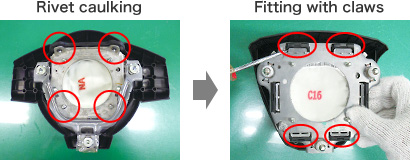
Novelty products using leather scraps
Leather scraps produced at Toyoda Gosei include pieces that have blemishes remaining in the hide. These pieces have been disposed of as waste, but employees proposed producing novelty goods using scrap leather as one activity to reduce workplace waste. Their efforts succeeded in creating marketable products and have led to a reduction in waste.
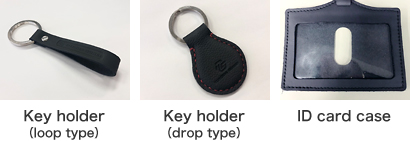
Reduction of packaging in the distribution stage
The packing material used in product transport is being reduced to prevent products from being dirtied by increasing the number of times reusable containers are used in the field and maintaining cleanliness. We are also reducing packing material by putting lids on reusable containers and other changes, considering the balance between maintaining product quality and reducing the use of packing materials.
■Amount of distribution packing material used/Amount used per sales unit (index)*4
Toyoda Gosei Co., Ltd.
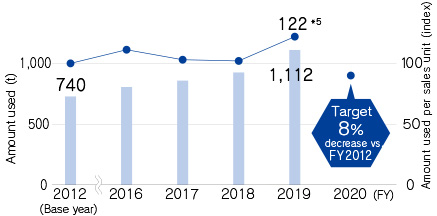
- *4 The amount of distribution packing material used per sales unit (index) is a figure obtained taking the base year as 100
- *5 The amount of packing material used increased with increased shipments of service parts due to natural disasters and larger part sizes.
Reducing water risks
To achieve the 2020 targets, we are working on kaizen through TG ESCO (expert team that conducts reduction activities with genchi-genbutsu) activities. Today, water use has been reduced 24% compared with FY2012 levels by decreasing loss and leakage in water use amounts.
Wastewater treatment facilities are also being systematically upgraded to improve our processing ability so that wastewater is cleaner and the water recycling rate is higher. We will continue our efforts for improvement by identifying risks in each country and region where we do business based on the increasing importance of water.
■Water use, water use per sales unit (index)*6
Japan, consolidated
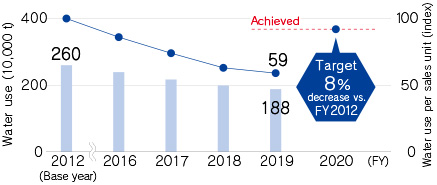
Toyoda Gosei Co., Ltd.
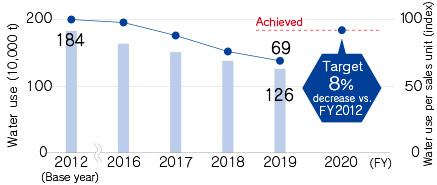
Overseas affiliates
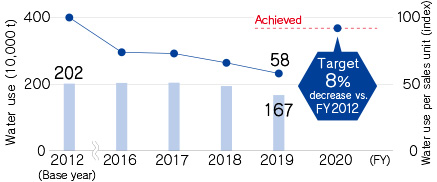
- *6 Water use per sales unit (index) is a figure obtained taking the base year as 100
Wastewater treatment facility at Morimachi Plant upgraded
The wastewater treatment facility for production processes at the Morimachi Plant, which had been in use for more than 30 years, was upgraded in FY2018. With the adoption of more advanced processing (membrane bioreactor) and a constant monitoring system, a cleaner and more stable water quality than before is achieved in wastewater. Future use as coolant water is under investigation.
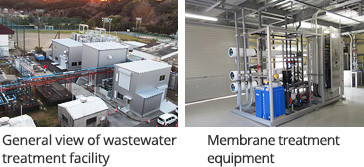
Reduced water usage with the use of rainwater
Toyoda Gosei Group company Hoshin Gosei Co., Ltd. reduced water usage about 3% by recirculating water in production processes, installing green curtains, and using rainwater to water plants in employee rest spaces.
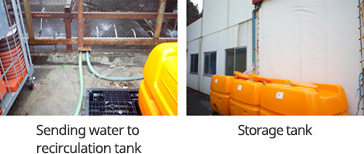
- Contributing to Environmental Preservation Through All Our Business Activities
- Sixth Environmental Action Plan Activities and Results
- Building a decarbonized society
- Building Recycling Societies
- Environmental Preservation and Building Environmentally-Friendly Societies
- Environmental Management
- Environmental Efforts at Affiliated Companies
- Environmental Data
- Third-Party Verification
- TCFD Index
- Third-Party Assessment